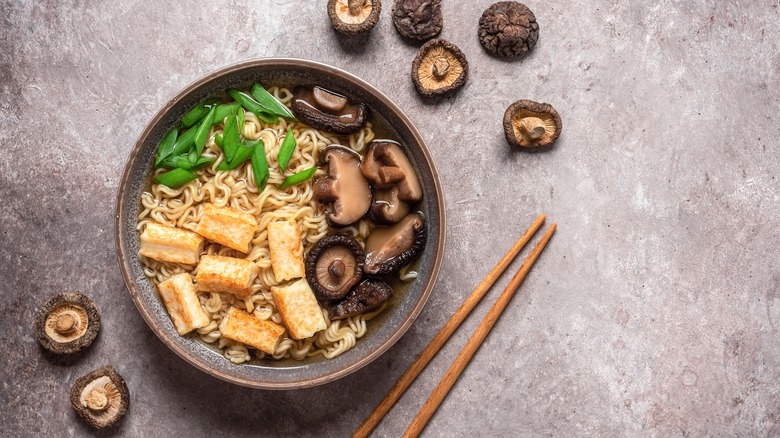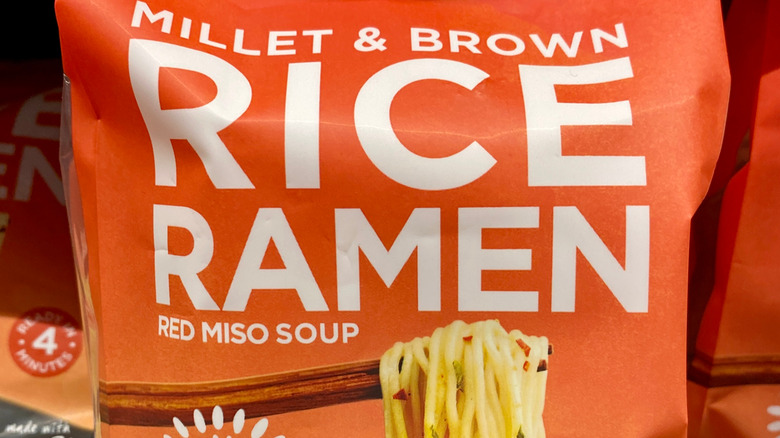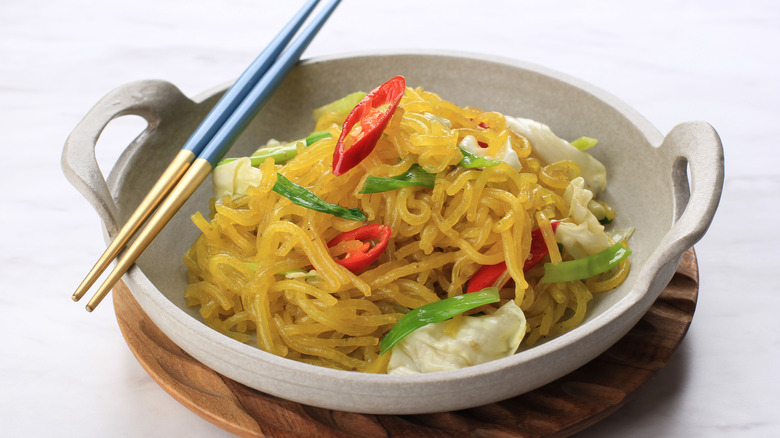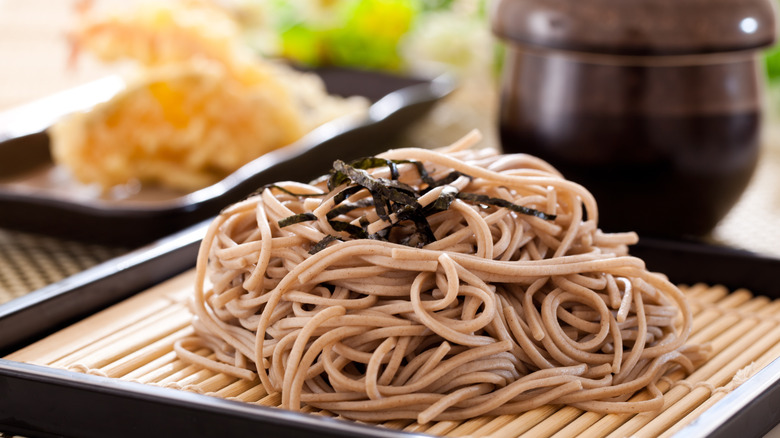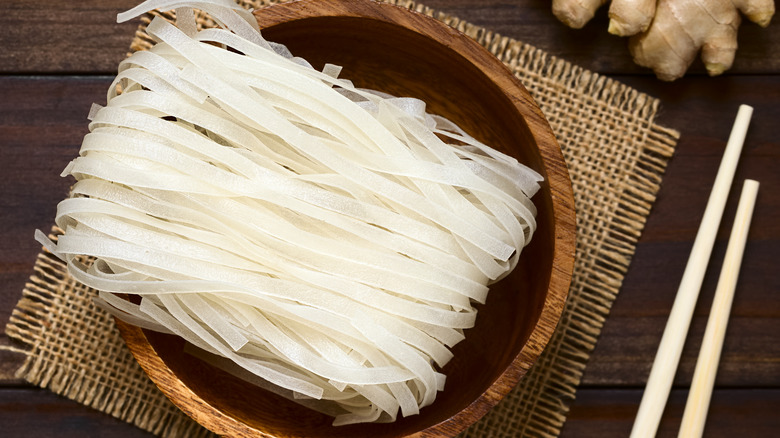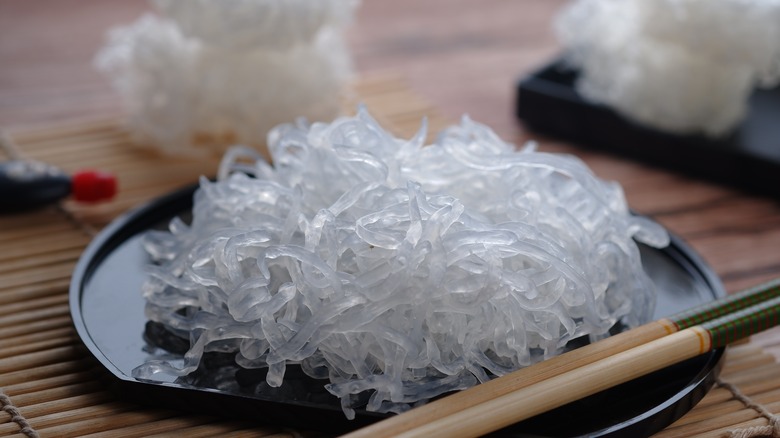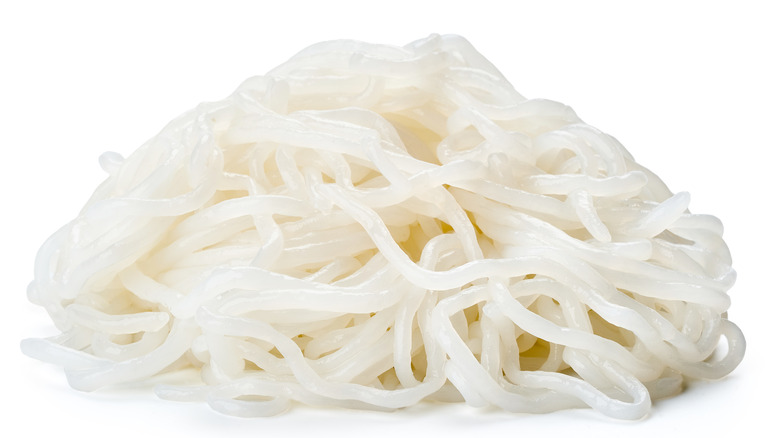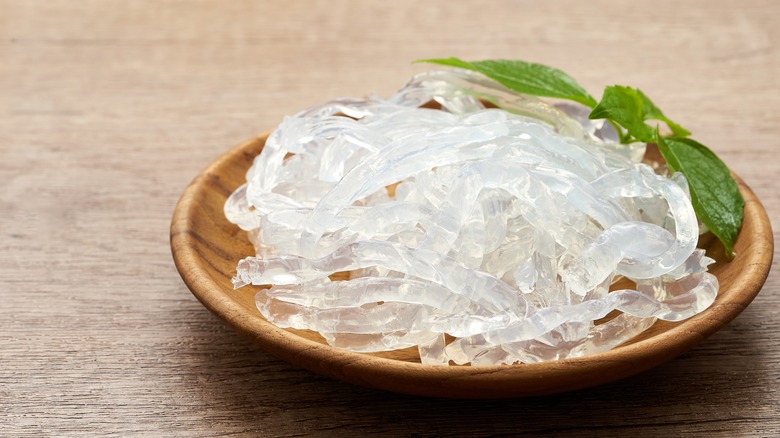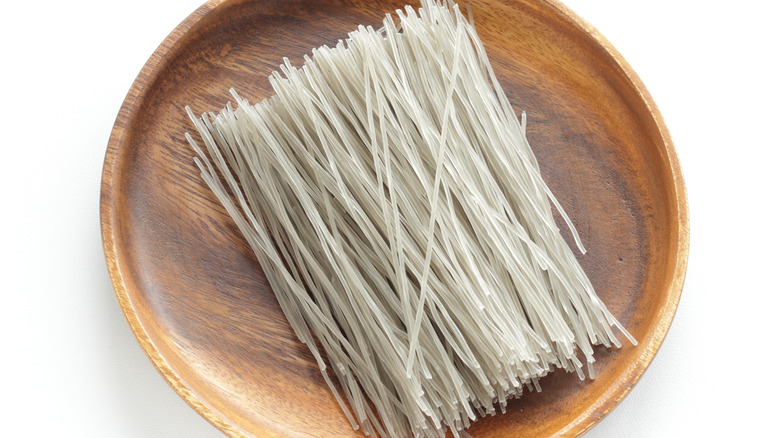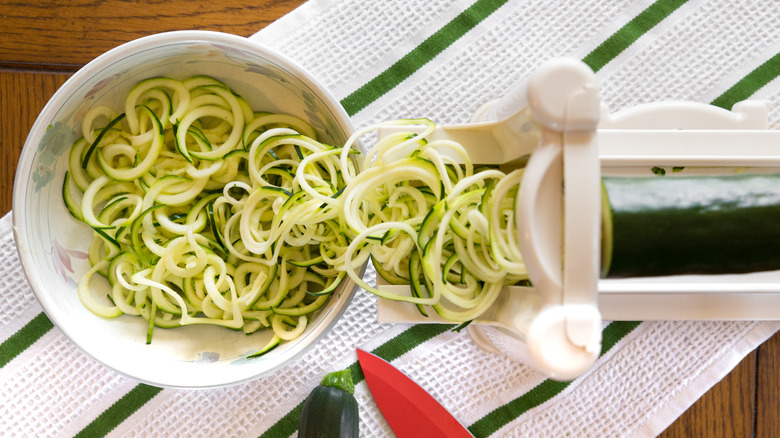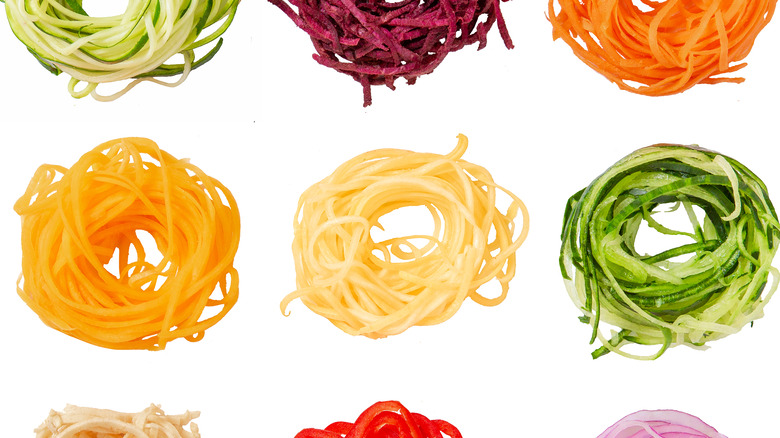10 Gluten-Free Ramen Noodle Alternatives
Think you know everything there is to know about ramen? This delicious, filling, meal-in-a-bowl can be altered to fit just about every diet out there. Vegetarian, vegan, pescatarian, carnivore — the culinary world has got you covered with a ramen recipe you'll love. But for those of us that are gluten-free, traditional wheat-based ramen noodles represent a huge hurdle we simply can't afford to ignore. The buck seems to stop here, and we end up missing out on a world-renowned favorite.
But do we have to?
Ramen, as a dish, can be as versatile as we want it to be, which leaves the door open for creative chefs to do what they do best. Purists may disagree, but here at Tasting Table, we want delicious recipes to be available to as many epicureans as possible. That's why we've pulled together a list of 10 gluten-free ramen noodle alternatives. Some are easy to find at the supermarket; others will be fun to make from scratch in the kitchen. Either way, they will not only get the job done, but they'll also garner the praise of all those you serve without wreaking havoc on anyone's sensitive digestive system.
1. Millet and brown rice ramen
If you're a stickler for texture and insist on keeping recipes as true to form as possible — even when you have no choice but to make a substitution — then the millet and brown rice gluten-free ramen noodles from Lotus Foods make an excellent go-to choice. These are as close to the real deal as you can get, and they even look the same. You might be surprised when you open the package to find the same kind of rectangular bricks of dehydrated noodles you're used to seeing with classic ramen.
They take only four minutes to cook, so just like traditional Japanese-style ramen, these gluten-free noodles will be ready to eat in no time. The Lotus brand product has exactly two ingredients: millet and brown rice. They offer a slightly nutty flavor. They're also low in fat yet high in protein (4 grams per serving) and fiber (2 grams per serving). Lotus Foods gluten-free ramen noodles are easy to find at most grocery stores.
2. Tapioca noodles
Tapioca noodles come to us from Vietnam, where they are called hù tiéu dai. These noodles typically have three simple ingredients, including tapioca, water, and salt. If you find yourself wondering, what is tapioca, and what does it taste like, for the most part, it can be thought of as cassava root flour — milky and slightly starchy. Noodles made from this flour are naturally gluten-free and neither healthy nor bad for you because they're neutral; tapioca noodles offer almost zero protein, fiber, or fat. As we mentioned, tapioca noodles also lack flavor, which should not stop you from using them in your ramen. The flavors of your spices carry much more value.
According to Kim Bao Kitchen, dai means chewy or tough. It is recommended that these noodles be soaked for close to a day before cooking so they become supple enough to work with. After soaking, they only need 30 seconds of cooking time. If you prefer not to soak them, it should still only take about 4 minutes to whip up a batch.
The only drawback with tapioca noodles is they may prove difficult to find. If you have a Vietnamese market in your town, you'll be all set. Otherwise, check other Asian markets or search online.
3. Buckwheat soba noodles
With a name like buckwheat, you may think we've forgotten the whole point of a gluten-free diet. As it turns out, buckwheat is classified as a pseudocereal because, like quinoa and amaranth, it comes from a seed and does not grow on grass, per Healthline. In terms of nutrition, buckwheat is high in antioxidants and minerals.
The World's 50 Best describes soba as a spiritual food within Zen Buddhist traditions. As far back as the middle ages, monks have been known to eat soba before meditating or fasting. Over time the practice became so popular that temples started producing and selling the noodles; only some earned the coveted status of goyo-soba-tsukasa, which gave them permission to offer their noodles to the royals in Kyoto.
While, in particular, there are things vegans need to know about soba noodles, it's important to note that not all of them are gluten-free. Some makers like to include a small proportion of wheat for texture, so read the package ingredients closely before making a purchase. Another option is to buy dried buckwheat and make them from scratch at home.
4. Rice noodles
Sometimes referred to as rice vermicelli, rice noodles are versatile in recipes and easy to come across in standard grocery stores. They are made from rice flour and water, with occasional additions of cornstarch or tapioca for texture, so there's no reason at all to omit them from your gluten-free diet. There are many different types of noodles out there, and you're likely to find rice-based ones in a range of different widths and thicknesses. These can vary from super thin sticks to thicker or even wide, flat noodles.
Rice noodles come out of the bag looking similar to traditional ramen yet not packed as tightly together. You'll get a mellow rice flavor from them; for the most part, they'll exist for texture and soak up the seasoning of your sauce.
Don't stop with ramen when it comes to rice noodles. This popular ingredient is the standard for pad Thai recipes and can be found in popular dishes just about everywhere.
5. Shirataki noodles
Shirataki may translate from the Japanese to white waterfall, but here in the U.S., this ramen alternative gets the nickname of miracle noodle. This is likely because they can satiate a hungry belly without supplying too many calories. They are carb-free as well!
Healthline explains that translucent shirataki noodles are made from glucomannan. This fiber from the tropical konjac plant has proven itself to be beneficial for people who are trying to lose weight. It seems crazy, but shirataki noodles are actually 97% water. One thing they do contain is soluble fiber, which passes through your system intact. Once it hits your stomach, it aids in digestion and feeds healthy gut bacteria.
Interestingly, shirataki noodles do not need to be cooked. It would be worth tossing them into your ramen a minute or two before it's done to warm them up, but you don't need to. You could easily pour them from the package into your bowl, give them a quick rinse, and then top them with the rest of your ramen ingredients.
6. Cellophane or glass noodles
Glass noodles are another neutral flavor option, though you might taste of hint of sweetness or nuttiness from the mung beans, which are the primary ingredient here. Some products will have pea starch mixed in as a dough conditioner; other than that, it's just starch and water.
From their looks and their name, you may be concerned that glass noodles are too delicate to maintain a noodle consistency in hearty ramen. That's not the case, according to the pros at Sous Chef UK, who say glass noodles increase in firmness through cooking.
Shopping for glass noodles will undoubtedly yield identical-looking products with ever-so-slightly different names. That's because glass noodles are also called bean thread or mung bean vermicelli. To make matters a touch more confusing, you'll also see them labeled as cellophane noodles. Then there's bún tàu in Vietnamese, dangmyeon in Korean ... it's a long list for a noodle that is well-loved across many different cultures.
7. Kelp noodles
Next, we jump into the sea for what Super Food Evolution calls a semi-transparent noodle suitable for a raw vegan diet. In order to process kelp seaweed into a noodle, the gelatinous inner flesh is removed, dried, and pulverized into a powder. This is then mixed with water and sodium alginate from brown seaweed, which works as a thickening agent. Alginate is also touted for its ability to remove toxic heavy metals.
There are many types of seaweed, and how to eat them varies across cultures and markets. But, the thing that stays the same is that seaweed is well-regarded as a healthy snack. These noodles fit right into that category too, except that creating the noodles requires the removal of the outer green sheath of minerals and chlorophyll. In the end, kelp noodles are not as nutritionally beneficial as straight seaweed, but they're still low in calories and retain some naturally present iodine.
For flavor, kelp noodles will likely give off at least a whiff of the salty sea from whence they came. Like shirataki noodles, they don't technically need to be cooked and probably shouldn't be. This is one noodle that can get soggy in boiling water. Better to simply soak them and toss them into your ramen recipe at the very end.
8. Potato or sweet potato starch noodles
Who knew that the world-favorite spud — along with its similar yet oh-so-distant relative, the sweet potato — could be used to make an acceptable substitute for ramen noodles? We sure didn't. But we were excited to find out. What to Cook Today says it's the starch that gets used in noodle preparation, so in that way, this process is not very different than the ones used to create many of the other noodles on this list.
Potato starch is not the same as potato flour, so don't confuse the two when shopping for ingredients. From there, all you'll need is boiling water to gelatinize the starch into a paste, which you'll pour into a standard piping bag. Squeeze strands of starch into a pot of boiling water, cook until they float (about 30 seconds), and rinse your final product in cold water. Voilà! A new way to eat potatoes that you probably never tried before.
According to Sous Chef UK, sweet potato vermicelli, as it's sometimes called, will start out with a grayish purple tint that will become translucent as the noodles are cooked.
9. Zoodles
Zoodles — zucchini run through a spiralizer so that they look like long thin noodles — have been around longer than you thought. Because the only ingredient is the vegetable, they can be cooked in all the same ways as any summer squash. "But, aren't squash about 94% water?" you may wonder with a concerned look on your face. The short answer is yes, but we know the trick to making zoodles in a way that keeps them from getting soggy.
Step number one is to choose a medium-sized zucchini at the market, even though the larger ones are calling to you. Medium zucchinis win out in flavor and contain less water from the get-go. Step two is to salt them after they've made their way through the spiralizer. The head chef for Noodles & Company takes the preparation one step further by running his salted zoodles through a salad spinner.
Like shirataki and kelp noodles, zoodles are fine to eat raw. There's also no problem tossing them into your ramen mixture as it's cooking.
10. Spiralized vegetables
Zucchini is far from the only option when it comes to spiralized vegetables. In fact, there are all sorts of vegetables you probably never knew you could turn into noodles. Carrots and beets will work perfectly. Cucumbers are another option. Just be sure to take in the same considerations when selecting for size. Salt your vegetable noodles as you would your zoodles and run them through the trusty salad spinner for good measure.
Aside from squash, root vegetables seem to be the most popular choice. A word to the wise here: While beets make great noodles, that juice gets really messy. Suit up and cover your counter with parchment paper or some other type of protective layer before risking a mess from the spiralizer.
So, if zucchini noodles are called zoodles, it seems logical that we would call carrots, coodles; parsnips, poodles; and turnips, toodles, right? Logical might not be the best word here, but it sure is fun!
